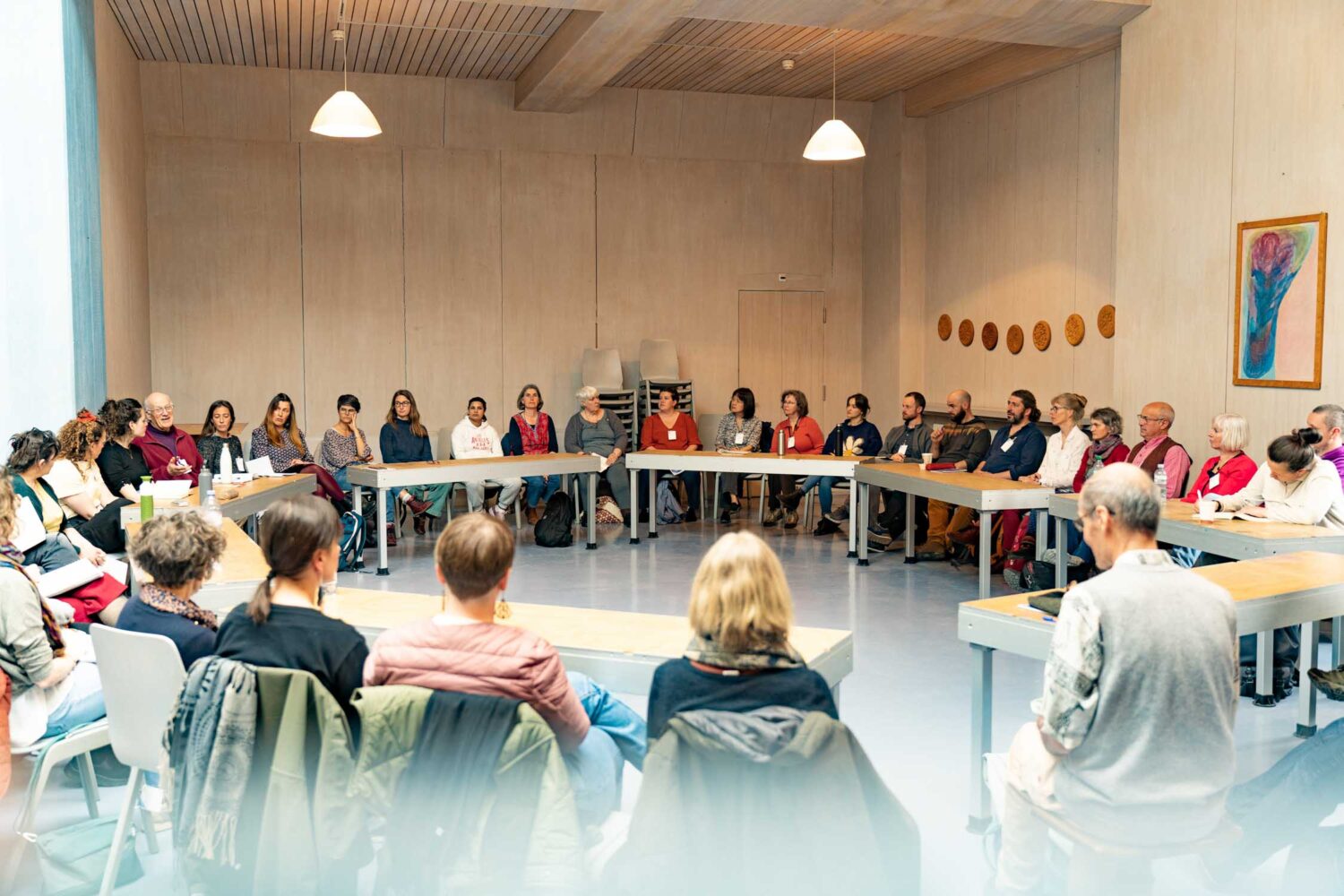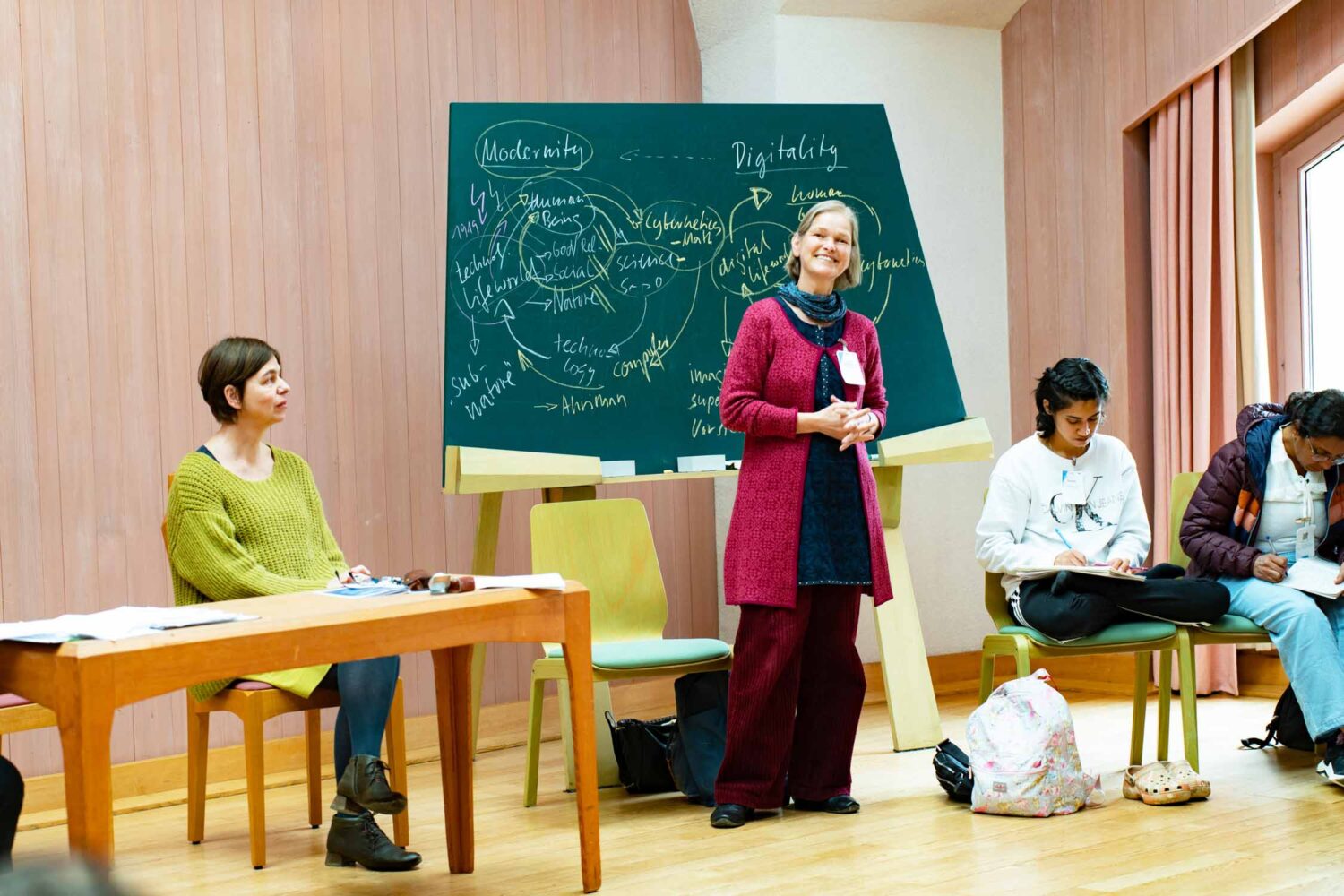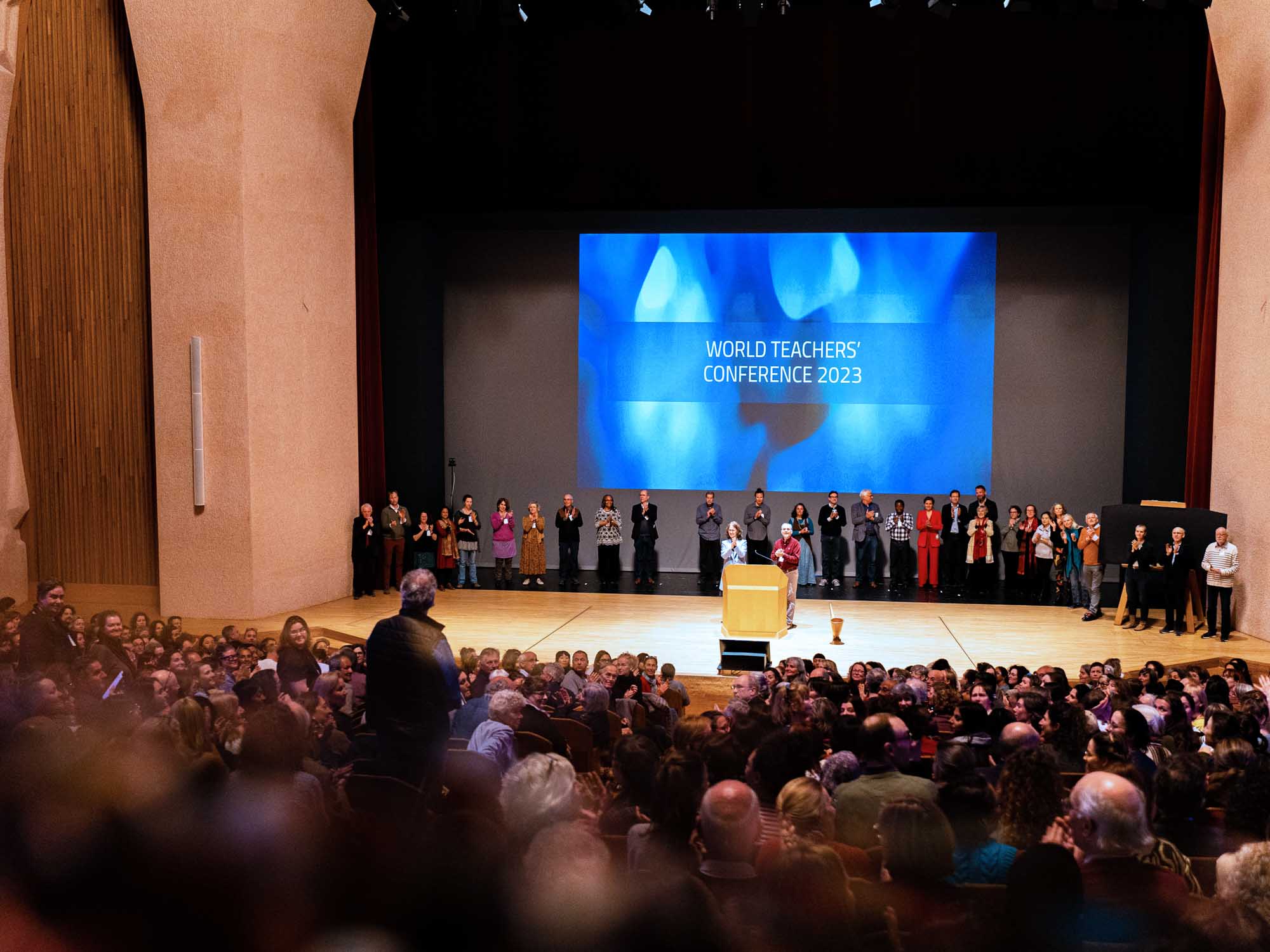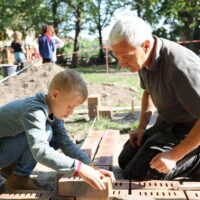More human, more world: this was a guiding motif in Josep Maria Esquirol’s opening lecture, echoing what lived at the Goetheanum during the World Teachers’ Conference. More human, more world: the child trusts the teacher because the teacher tries to stay steeped in the world, because they always engage with the world anew—recognizing it, affirming it, wanting it—and because they are oriented towards the child—affirming their presence, seeing them, recognizing their potential. Rudolf Steiner shows this dual devotion to be the basis of education—a prerequisite for the relationship between child and teacher on which learning about the world and participation in the reality of the world is founded.

The child at the center, the world at the center—both live simultaneously in the consciousness of the teacher. Two centers, that together form the twin foci of an ellipse of attentiveness. Educational attentiveness is like moving along this ellipse: now closer to the child, then closer to natural phenomena, to a story, closer to a mathematical equation, to a discovery—closer to the richness of the world’s phenomena. Teachers can develop this sensibility for closeness and for perceptive, attentive distance—a divining, probing sight that is turned towards the child, towards the nascent human being, towards the new citizen of the world who wants to be a fellow citizen of a common world.
Learning for the One World
Thus learning is learning for a common world. We know ourselves to be together, dependent on each other, reciprocal, unique and one of a kind with all others who are also one of a kind. The knowledge of our common world and the freely and individually grasped responsibility for it forms the fertile ground for education and for society. Educational questions are social questions. Rudolf Steiner formulated this increasingly visible reality early in the twentieth century.
Over Christmas and New Year 1922/23, Rudolf Steiner gave a lecture series entitled The Origins of Natural Science. He did not address the lectures specifically to teachers, but he pointed to a crucial turning point for teachers: the century in which modern natural science was born—the century that lies between Nicolaus Cusanus’ Docta ignorantia in 1440 and the publication of De revolutionibus orbium coelestium by Nicolaus Copernicus in 1543. The developments that followed these birth moments brought people “renunciation and fertilisation in the life of the soul.” 1
Much, indeed most, of what we know stems from a perspective born in modernity: the image of the human being and the universe that underlies natural science, the methods and forms of cognition, content as the object of a subject facing it. From the fifteenth century onwards, an awareness emerged that the earth as an object belongs to the human being. The world is surveyed in the modern era, time is ordered. The developments of natural science show the human being in their power and their urge for possession, up to and including domination and, beyond that, systematic destruction. Four hundred years later, the threat posed to people and the world by this power becomes existential.
In the twentieth century, however, another form of the relationship between the world and the human being also begins. A humanity without domination. A growing awareness of the necessity to take responsibility for conditions of life on earth and for human beings. Hans Jonas articulates that dependency is not an expression of deprivation or powerlessness but of development, of complexity and differentiation.2 It is a matter of being alert and attentive to a new knowledge about the humanity of the human being in their constant vulnerability, about humanity as a natural gift that must be protected and nurtured.

The Other Who Sees What I See
For such a beginning Rudolf Steiner developed an anthroposophical spiritual science. “More world, more human” means something different at the turn of the twentieth century than “more world” at the moment when natural science emerges. Cognition without domination is not powerless in the face of world events: cognition becomes active participation in the development of the world, in the development of the human being. Rudolf Steiner founded the School of Spiritual Science for this search for cognition, its development, its methods, and its efficacy.
The most important thing in this respect is an understanding of the human being, an image of the human being as the basis for education—not as a normative measure but as orientation for “perceptive cognition”, for learning to perceive the uniqueness of the actual child, the actual adolescent. The decisive factor is the perspective of an ‘I’ for which the other and the world are constitutive, indispensable experiences. “The ‘I’ is real through its participation in reality. It becomes more real the more complete such participation.” 3
Learning needs the other. For the child and for the growing young person, learning is a process in the direct relationship to another person—it takes place in the face of the other. It needs the other who sees what I see, to whom I can show what I perceive, who shows me what there is to see, what there is to know, what there is to understand. The beauty of the world is revealed in its communication.
Learning is based on relationship. The latter changes, develops, is in motion. Teachers are mandated by society to take responsibility for the possibilities of relationship. They have to mediate relationship, to enable it, to promote it, and for that they themselves must become ‘more world’, more human.
The central motifs of the conference were nurturing, affirming, trusting—the foundations of education and existential conditions for the development of the child.

“The Taste of Childhood—Delicious Food”
Body and soul need nourishment. Both forms of nourishment interweave in experience and in memory. A class teacher from a school in a big city in Brazil tells a memorable story. She attended this same school as a child, at a time in her life when there was a shortage of food for the family. “I think all the former pupils will talk about the food.” In recounting their experiences, the sensations of childhood and food overlap—both are an expression of the same, the taste of childhood and the taste of delicious food. “For us, it’s the taste of childhood, it’s what has lived in us since we were little. […] I was in day care from a very early age. This is the taste of childhood: the delicious food. […] Yes, the smell of the food when it arrives in the classroom, it’s a very affecting smell, very strong, it’s what stays. […] the taste of childhood—delicious food.”4
Food as dual nourishment: as fortification for the body, as spiritual care: “We were made very welcome—it was very important for our education as human beings, very important for me and for my family, because my mother went to work, my father too, and they came home late. So we learned that we had food here [at school] and they [the parents] didn’t have to worry. […] our second home, that’s the taste of childhood and the sacred food we sometimes didn’t have at home.”
As a teacher, she wants to bring the children what she received as an indispensable gift. “And because I had the experience that you can eat at school when I was a child, I want to give that experience back and make it possible for the children who attend the school now. I really enjoy cooking for them [the pupils], as if it were the final meal, the most delicious meal, as if it were the last meal in life, so that they can have that pleasure. That is very important here—here, in this educational community.”
“The Love of the World Establishes the World for Me”.
Amo: volo ut sis—Love: I want you to be. This is how Augustine, Duns Scotus, Hannah Arendt formulated love as an expression of the intensified will. Love is affirmation of the other person. In a 1966 lecture on questions of ethics, Hannah Arendt says, “With Augustine: Amo: volo ut sis (I love you means: I want you to be). My affirmation of what is, or who is, brings me into relation with what is in any case, just as my negation alienates me from it. In this sense, the world is ‘dilectoris mundi’, the ‘lovers of the world’ are the world. Or love of the world establishes the world for me, fits me into it.”5
For the child, this volitional affirmation is expressed in the affirming environment. In the experience of enveloping goodness in the first years of life, in the experience of being seen and learning to see the beauty and diversity of the world, in the experience of being recognised and being able to recognise. The question arises insistently: does the child find an environment in which such experiences can be its reality?
“Trust in the World Because This Person Exists”.
“Trust, trust in the world because this person exists—that is the innermost work of the educational relationship”6 says Martin Buber in his 1925 Speech about the Educational. And in 1922 Rudolf Steiner said to the young people, many of them teachers, that education must be oriented towards trust, “trust in a very concrete sense, individually, uniquely shaped”. 7
Trust, affirmation and a nurturing environment live through human devotion, through the decisions of people regarding the conditions of life and the development of children and young people. A worldwide association for education—this is what Rudolf Steiner hoped for from the summer of 1920 onwards.8 UNESCO 20219 points to the need for a worldwide federation for education, based on the existential experience of fragility, vulnerability and mutual dependence that became glaringly obvious not least during the pandemic.
In the World Teachers’ Conference, a worldwide living connection to the child, to the nascent human being, became visible in its many manifestations. To unite for the task of strengthening the human forces in the human being in every situation, under all circumstances, no road is too far, no time too precious.
A big thank you to all the teachers, faculties and schools who made this conference possible. It was dedicated to the child and to the question posed through every child to the world and to the other human beings: “Is it possible for me to actively participate in this common world?” To be able to meet this expectant question anew, time and time again, is the daily task of education. Children and young people hope that there are people who are committed to this task and stay connected for it—in living learning for the common world.
Translation Christian von Arnim
Photos Xue Li
Footnotes
- See Rudolf Steiner, The Origins of Natural Science, Lecture 1, GA 326.
- See ‘Lehrbriefe an Lore Jonas’ (‘Introductory Remarks by Lore Jonas’), in: Hans Jonas. Erinnerungen (Memoirs). Frankfurt am Main 2005, S. 359.
- Martin Buber, ‘I and Thou’, in: Das dialogische Prinzip (The Dialogical Principle), Gütersloh13: Gütersloher Verlagshaus, 2014, p. 66.
- Constanza Kaliks, Reciprocidade e diálogo no contexto educativo: perspectivas de pessoas envolvidas em projetos escolares em São Paulo e Buenos Aires (Reciprocity and dialogue in the educational context: perspectives of people involved in school projects in São Paulo and Buenos Aires), 2022, p. 93.
- Hannah Arendt, Über das Böse. Eine Vorlesung zu Fragen der Ethik (On Evil. A Lecture on Questions of Ethics), Munich, 4th edition, 2010, p. 165.
- Martin Buber, ‘Rede über das Erzieherische’ (‘Speech on the Educational’), in: Martin Buber, Schriften zu Jugend, Erziehung und Bildung (Writings on Youth, Upbringing and Education), Gütersloh 2005, p. 150.
- Rudolf Steiner, ’Geistige Wirkenskräfte im Zusammenleben von alter und junger Generation’, Pädagogischer Jugendkurs (’Spiritual forces of action in the coexistence of old and young generations’, Pedagogical Youth Course), Dornach, 6th edition, 1988, p. 94.
- See also Rudolf Steiner, Die neue Geistigkeit und das Christus-Erlebnis des zwanzigsten Jahrhunderts (The New Spirituality and the Christ Experience of the Twentieth Century), GA 200, Dornach, 4th edition, 2003, p. 29 f; Rudolf Steiner, Erziehung zum Leben. Selbsterziehung und pädagogische Praxis (Education for life—Self-education and Pedagogical Practice), GA 297a, Dornach, 1998, p. 33; Rudolf Steiner, Erziehungs- und Unterrichtsmethoden auf anthroposophischer Grundlage (Education and Teaching Methods Based on Anthroposophy), GA 304, Dornach, 1979, p. 56.
- See UNESCO, Reimagining our futures together, France, 2021.





